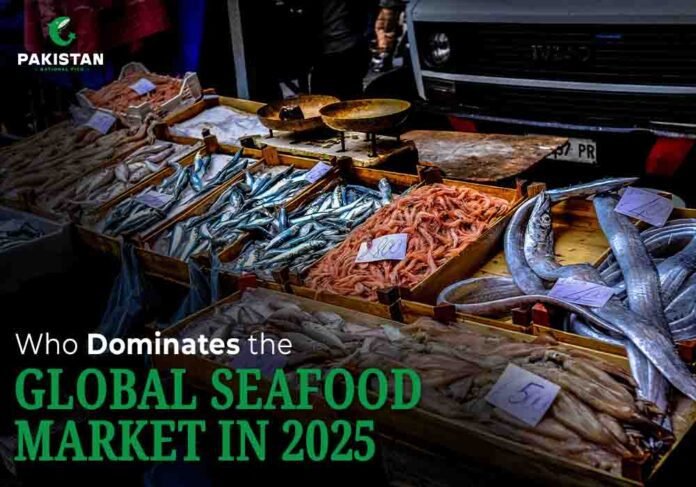The seafood industry has always been a vital part of the global seafood economy, but in recent years, its growth has been nothing short of remarkable. The fishing industry worldwide was valued at USD 368.98 billion in 2024 and is expected to reach USD 386.99 billion in 2025, on track to surpass USD 651.39 billion by 2032. That means the business is growing at a steady CAGR of 7.72%, fueled by high demand, healthier eating habits, and the shift toward healthy lifestyles.
So, what is the global profitability of the fishing industry? By 2025, the number is already in the $300+ billion range—and it’s only heading upward.
How Is the Seafood Industry Doing?
If we look at consumption trends, the sea fish industry is thriving. As consumers in both developed and developing countries move away from chicken and red meat, they are eating more fish, shrimp, crabs, lobsters, and mollusks.
The appeal is straightforward: seafood offers omega-3 fatty acids, which are best for heart and brain health, and the same amount of protein with fewer calories.
Seafood has long been a mainstay of Asian diets, especially in China, Japan, South Korea, and Thailand. Today, global seafood demand is also rising in North America and Europe, particularly for high-end and processed options like smoked, canned, and frozen fish.
In the meantime, the global fish business keeps expanding, providing luxury goods for health-conscious consumers prepared to spend more for superior quality as well as convenience goods for time-pressed city dwellers.
What Makes the Global Seafood Industry Tick in 2025?
Picture yourself swapping stories with a grizzled fisherman over a plate of fresh catch — that’s the vibe I get when I think about this industry. It’s not just about hauling nets. Seafood is a huge engine that supports jobs, feeds millions, and keeps whole local economies moving. In 2025 the global seafood market is roughly $387 billion (up from about $369 billion last year).
But it’s not all smooth sailing. Sustainability fights, tech upgrades in farms, and trade policy drama are reshaping the scene. Tariffs have become a real headache — in some cases they’ve pushed import costs sharply higher (we’re seeing ranges reported from roughly 10% up to 46% on certain products), and that’s changing where seafood flows and how much consumers pay.
So why is demand climbing? With the world’s population and appetite for protein on the rise, people are choosing lean, nutrient-packed seafood more often (hello, omega-3s). At the same time, aquaculture — fish farming — now supplies more than half of the seafood we eat, meaning farms have overtaken wild catch as the main source. That’s a huge structural shift.
Global Seafood Tariff Trends: What’s Hot and what’s not
Trends in the seafood world are a lot like tides — always shifting. And in 2025, the biggest wave is all about sustainability. Shoppers aren’t just buying fish; they’re looking for a clear conscience with every fillet.
Sales of eco-labeled, MSC-certified seafood are up about 25%, showing that people are willing to pay for responsibility. Add to that the rise of plant-based seafood alternatives — think tuna made from peas or seaweed “shrimp” — and you’ve got a whole new menu driven by concerns over overfishing.
Health: Seafood’s nutrition profile is still its biggest selling point. About two-thirds of buyers say they pick it for heart-friendly omega-3s. No Tran’s fats, just clean protein that makes you feel good about your choices.
Flavor mix: Dinner plates are getting bolder. Picture a classic white fish fillet, but with a fiery Korean chili glaze or a Thai-inspired coconut curry twist. The motto for 2025? “Local Goes Global.”
Whose Country is worth in the Fishing Industry Worldwide?
In 2025, the fishing industry is expected to be worth $731 billion, with aquaculture making up more than half of that total. That’s not just boats and hooks—it’s processing, shipping, and selling on a global scale. Per capita, folks chow down about 20.7 kg yearly, up from decades ago, feeding 3.2 billion with vital proteins.
Key facts? According to The Asia-Pacific region holds the biggest part of the market—over 44%, like China and India.
But here’s the point: tariffs are pushing import costs up by 10–46%, and that pressure is being felt across the global fish trade.
If you’re thinking about investing, the real opportunity isn’t in chasing volume—it’s in sustainability. Certified fish farms and eco-friendly operations are where smart investors are casting their nets these days.
Tariffs' Effect on International Seafood Sales: A Real Game-Changer
Back to that storm I mentioned—tariffs are slamming the international seafood market like a rogue wave. A 10-46% increase in Chinese and Vietnamese tariffs in 2025 is expected to boost prices by 10%, reduce U.S. imports by billions, and shift flows to Norway and Chile. Result? Americans eat less heart-healthy shrimp/salmon, more red meat—bad news for health.
- Winners: Low-tariff spots like Ecuador thrive.
- Losers: Exporters like India lose $2.5B in U.S. sales.
- Global Ripple: Higher costs everywhere; seek trade deals to dodge.
How to adapt? Diversify markets—Asia’s booming for now.
Tariff Impact | Before 2025 | After Tariffs | Example Effect |
U.S. Shrimp Imports | $2B from Asia | +20% cost | Prices up, sales down 15% |
Salmon Flows | Chile/Norway steady | Shift to EU | Norway gains 10% market share |
Overall Sales | $731B global | -5% in affected trades | Korangi exports drop 20% to U.S. |
Inside the Largest Fish Market in the World
Fish Market Sales Breakdown and Numbers
Fish market sales at $31.5B in the U.S. alone for 2025, with worldwide retail hitting $18.8B last year. Fresh down 5%, frozen steady—convenience wins.
- Stats: Per capita U.S. intake: 19.7 lbs.
- Trends: Online sales up 15%; premium wild-caught premiums 20%.
Table of sales by type:
Category | 2025 Sales (Global, $B) | Growth Rate |
Fresh | 150+ | -5% (prices) |
Frozen | 120 | +3% |
Processed | 200 | +7% (canned) |
The Atlantic Fish Company: A Taste of Innovation
What Drives the International Fish Market Dynamics Today?
Include:
- Rising middle classes in Asia are premium imports.
- E-commerce is making cross-border sales easier.
- Sustainability certifications influence buyer choices.
Wrapping Up the Catch: What's Next for the $300+ Billion Seafood Saga?
Alright, folks, we’ve sailed through the wild, wavy world of the global seafood market, from China’s mega-farms to Tokyo’s Toyosu Market frenzy.
We’ve seen how tariffs affect international seafood sales, pushing prices up and challenging exporters.
Whether the Atlantic Fish Company’s fresh takes or starts its own seafood farm, one thing’s clear: this $387 billion industry (and counting!) is a dynamic, feeding billions and evolving fast.


